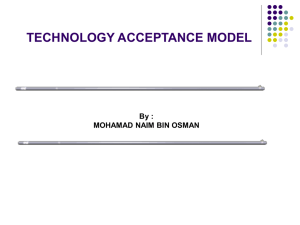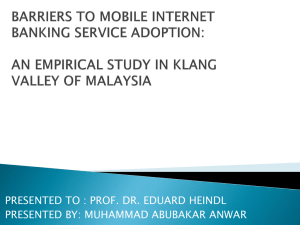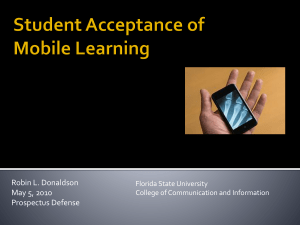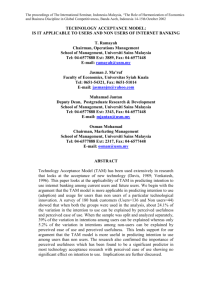A TAM Framework to Evaluate Users' Perception towards Online
advertisement
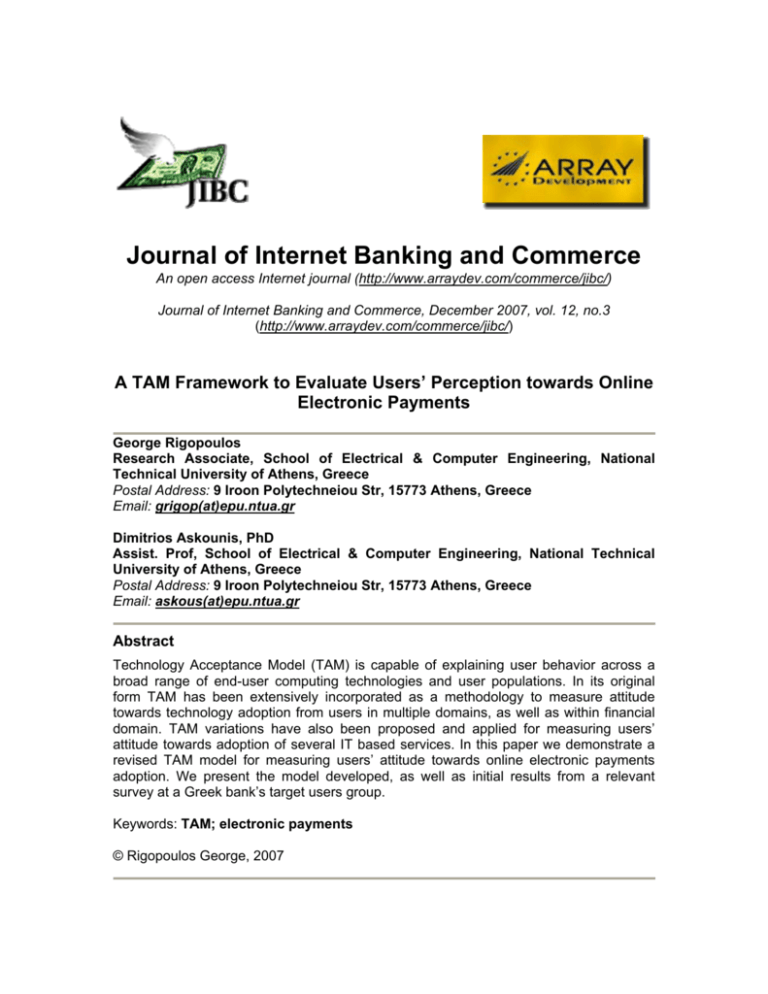
Journal of Internet Banking and Commerce An open access Internet journal (http://www.arraydev.com/commerce/jibc/) Journal of Internet Banking and Commerce, December 2007, vol. 12, no.3 (http://www.arraydev.com/commerce/jibc/) A TAM Framework to Evaluate Users’ Perception towards Online Electronic Payments George Rigopoulos Research Associate, School of Electrical & Computer Engineering, National Technical University of Athens, Greece Postal Address: 9 Iroon Polytechneiou Str, 15773 Athens, Greece Email: grigop(at)epu.ntua.gr Dimitrios Askounis, PhD Assist. Prof, School of Electrical & Computer Engineering, National Technical University of Athens, Greece Postal Address: 9 Iroon Polytechneiou Str, 15773 Athens, Greece Email: askous(at)epu.ntua.gr Abstract Technology Acceptance Model (TAM) is capable of explaining user behavior across a broad range of end-user computing technologies and user populations. In its original form TAM has been extensively incorporated as a methodology to measure attitude towards technology adoption from users in multiple domains, as well as within financial domain. TAM variations have also been proposed and applied for measuring users’ attitude towards adoption of several IT based services. In this paper we demonstrate a revised TAM model for measuring users’ attitude towards online electronic payments adoption. We present the model developed, as well as initial results from a relevant survey at a Greek bank’s target users group. Keywords: TAM; electronic payments © Rigopoulos George, 2007 JIBC December 2007, Vol. 12, No. 3 -2- INTRODUCTION In this paper we demonstrate a revised TAM model for measuring users’ attitude towards online electronic payments adoption. Since electronic payments represent a considerable part of banks’ retail portfolio, it is imperative that they adapt to technological innovations. Within this framework, a Greek bank plans to enhance its payment services portfolio for retail customers by offering a new service for secure payments. Our main objective is to study customers’ attitude towards the usage of the new service. We present the model as well as results from a relevant survey at a Greek bank’s target users group. The study was executed upon a focus group of selected bank’s customers, in order to measure attitude towards a new payment service, which will offer increased security on payments via Internet, and evaluate the approach towards a more advanced customer survey. Initial findings prove a positive relation between ease of use and actual usage of the new service. METHODOLOGY Technology Acceptance Model (TAM) was initially developed by Davis to provide an explanation of the determinants of computer acceptance. In general it is capable of explaining user behavior across a broad range of end-user computing technologies and user populations theoretically justified (Davis, 1989; 1993). TAM is based on the following core concepts: • • Perceived usefulness, which has been defined as a user's subjective perception of the ability of a computer to increase job performance when completing a task, and Perceived ease-of-use, which is a person's subjective perception of the effortlessness of a computer system, which affects the perceived usefulness thus having an indirect effect on a user's technology acceptance. TAM is derived from the Theory of Reasoned Action (TRA) model, which was developed by Fishbein and Ajzen to explain a broader range of behaviors based on situation specific combinations of personal beliefs and attitudes, and the effects of beliefs of others close to the individual (Szajna, 1996). The fundamental concept of TRA is that individuals will adopt a specific behavior if they perceive it will lead to positive outcomes (Compeau and Higgins, 1995). Technology Acceptance Model (TAM) has been extensively incorporated as a methodology to measure attitude towards technology adoption from users in multiple domains, as well as within financial domain. TAM variations have also been proposed and applied for measuring users’ attitude towards adoption of several IT based services. An extensive body of subsequent research has confirmed the usefulness of TAM – and various extensions and revisions – as a tool for investigating and predicting user information technology acceptance (Taylor and Todd, 1995), (Geffen and Straub, 2000); (Doll et al, 1998). In order to perform the research, we followed TAM methodology and concepts, and used a revised TAM model (Figure 1), as proposed by Money (Money 2004), in order to identify relationship between Perceived usefulness and Perceived ease-of-use, and JIBC December 2007, Vol. 12, No. 3 -3- customers’ intention to use and usage of the new payment service. Perceived Usefulness Behavioral Intention to Use Actual Usage Perceived Ease of Use Figure. 1. Research model (Money 2004) A number of factors affecting adoption of payment instruments has been identified in relevant studies, such as switching barriers between alternatives, attractiveness of alternatives and switching cost. However, the scope of this study has been relative limited and the model was close to the original TAM model. Major objective was to execute a preliminary research, in order to identify correlations between key factors and gather data to initiate a broader study. For this reason, we formulated a relative small number of research hypotheses as shown in Table 1 based on the model stated above. Table 1. Research Hypotheses H1 H2 H3 H4 H5 H6 Hypothesis Perceived usefulness will have a positive relationship with behavioral intention Perceived ease of use will have a strong indirect positive relationship to behavioral intention Perceived ease of use will have a less strong direct positive relationship to behavioral intention Behavioral intention will have a strong positive relationship to system usage Perceived usefulness and perceived ease of use will have a strong positive relationship to behavioral intention Perceived usefulness and perceived ease of use will have a strong positive relationship to actual usage In order to test the proposed research model, a field survey was carried out. The study was conducted in collaboration with a Greek bank. A focus group was selected form the bank according to bank’s marketing experts. The population of interest was customers who hold credit cards and use internet banking. Questionnaires based on the constructs depicted in Table 2 were used to collect the data. Items used Likert scales ranging from 1 = strongly disagree to 7 = strongly agree. Questionnaires were sent and collected through email. In total, 140 replies were collected, out of 160 customers, and 15 replies were discarded due to incomplete or insincere responses. Demographics of the sample are provided in Table 3. JIBC December 2007, Vol. 12, No. 3 -4- Table 2. Construct items The construct items Perceived usefulness 1. New payment service is useful for the purchase of goods/services. 2. New payment service makes the purchase of goods/services easier. 3. New payment service makes the purchase of goods/services more convenient. 4. New payment service makes the purchase of goods/services faster. Perceived ease-of-use 1. New payment service is easy to use. 2. New payment service is easy to understand. 3. New payment service is simple. 4. Using the new payment service can be easily skilful. Behavioral intention to use 1. I think that using the new payment service is a good idea. 2. I think that using the new payment service is beneficial for me. 3. I have positive perception about using the new payment service. Usage 1. I intend to use new payment service frequently. 2. I intend to use new payment service more than any other payment service. Table 3. Sample characteristics Total sample size (responded)125 Female Gender Male Demographics Mean Age 22.3 Years of IT use 7.2 Weekly Hours of IT use 16.3 Internet usage Percentage Daily 93.5 % Weekly 5.9 % Monthly 0.4 % A few times a year 0.1 % 67 58 Std. Dev. 7.6 4.5 13.7 RESULTS For the data analysis, we calculated Cronbach Alpha reliability coefficients for each construct as shown in Table 4. The reliability of all measurement scales was above the recommended minimum level of .70 and the desirable level of .80 for social science research. Table 4. Cronbach alpha Construct Perceived usefulness Perceived ease-of-use Behavioral intention to use Usage Cronbach alpha 0.898 0.922 0.889 0.990 JIBC December 2007, Vol. 12, No. 3 -5- Due to the limited sample size, statistical analysis was limited to correlation and regression analysis. Correlation analysis results appear in Table 5 which includes the observed correlations. Figure 2 also depicts the results and the associated p-values in accordance with the research model. Table 5. Correlation of constructs (1) (2) (3) Constructs (1) Perceived usefulness 1 0.880 0.661 (2) Perceived ease-of-use 0.880 1 0.676 Behavioral intention to (3) use 0.661 0.676 1 (4) Usage 0.560 0.519 0.430 Perceived Usefulness 0.661 <0.00001 Perceived Ease of Use 0.676 <0.00001 0.430 1 0.560 0.00004 Behavioral Intention to Use 0.880 <0.00001 (4) 0.560 0.519 0.430 0.017 Actual Usage 0.519 0.005 Figure. 2. Research model with correlations In Table 6, we summarize the findings regarding the research hypotheses resulting from the above data analysis, where all six hypotheses are supported. Table 6. Hypotheses results H1 H2 H3 H4 H5 H6 Hypothesis Perceived usefulness will have a positive relationship with behavioral intention Perceived ease of use will have a strong indirect positive relationship to behavioral intention Perceived ease of use will have a less strong direct positive relationship to behavioral intention Behavioral intention will have a strong positive relationship to system usage Perceived usefulness and perceived ease of use will have a strong positive relationship to behavioral intention Perceived usefulness and perceived ease of use will have a strong positive relationship to actual usage Support Yes Yes Yes Yes Yes Yes CONCLUSION In this paper, we present findings from a survey to identify customers’ attitude towards a JIBC December 2007, Vol. 12, No. 3 -6- new payment service. Our target was initially to evaluate TAM within this setting, and further to collect findings in order to continue to a wider research setting. Small sample is one of the limitations of the study. The sample was limited to one particular customer setting, at one point in time, and was therefore limited for broad generalizations. In order to generalize the results, further studies are needed in different contexts and settings. Another limitation was the distribution method of the survey instrument. The survey was delivered online by e-mail. Customers, who did not answer the e-mail, may not have received or completed the survey. Results of the study may have been influenced by a larger number of respondents. However, while the study provides preliminary results, these results provide a foundation for future studies for electronic payment adoption. References Compeau, D. Higgins, C. (1995). Computer Self-Efficacy: Development of a Measure and Initial Test, MIS Quarterly, 19(2), 189-211. Davis, F. D. (1989). Perceived usefulness, perceived ease of use, and user acceptance of information technology, MIS Quarterly, 13, 31-340. Davis, F. D. (1993). User acceptance of information technology: System characteristics, user perceptions and behavior impacts, International Journal of Man Machine Studies, 38, 475-487. Doll, W., Hendrickson, A., Xiandong, D. (1998). Using Davis’s Perceived Usefulness and Ease-of-Use Instruments for Decision Making: A Confirmatory and Multi-Group Invariance Analysis, Decision Sciences, 29(4), 839-869. Gefen, D., Straub, D. (2000). The Relative Importance of Perceived Ease of Use in IS Adoption: A Study of Ecommerce Adoption, Journal of the Association of Information Systems, 1(8). Money, W., Turner, A. (2004). Application of the Technology Acceptance Model to a Knowledge Management System, Proceedings of the 37th Hawaii International Conference on System Sciences (HICSS'04) - Track 8, 2004. Szajna, B. (1996). Empirical Evaluation of the Revised Technology Acceptance Model¸ Management Science, 42(1), 85-92. Taylor, S., Todd, P. (1995). Understanding Information Technology Usage: A Test of Competing Models, Information Systems Research, 6(2), 144-177.
